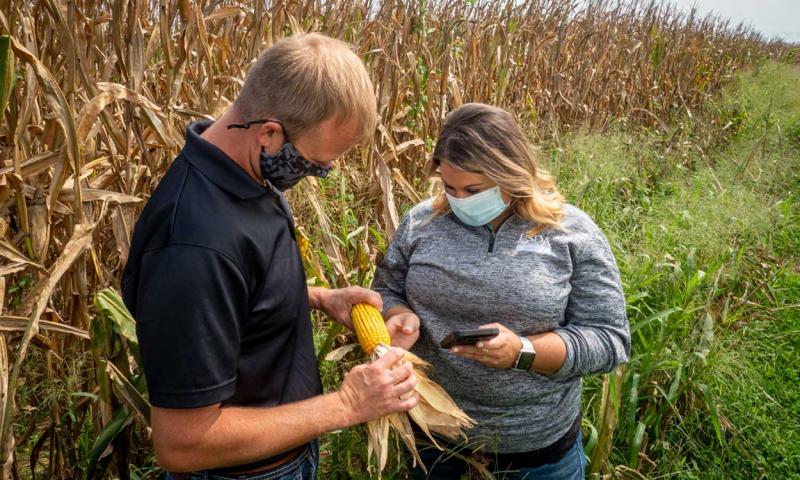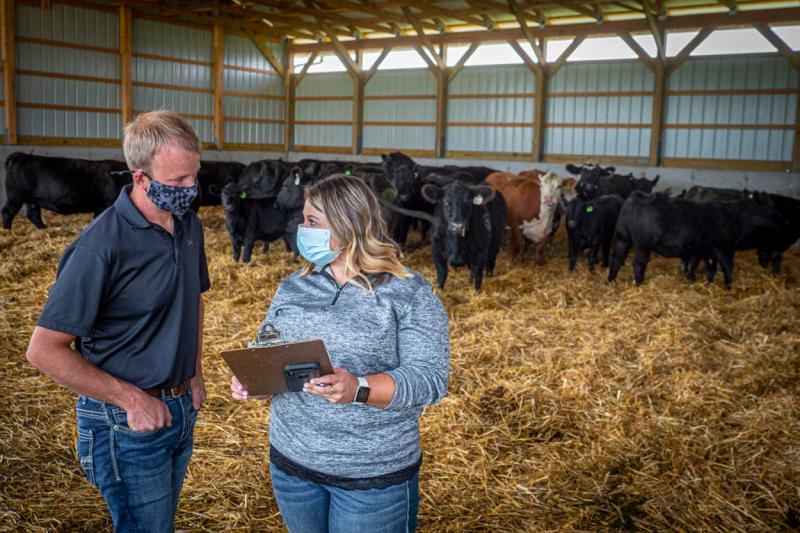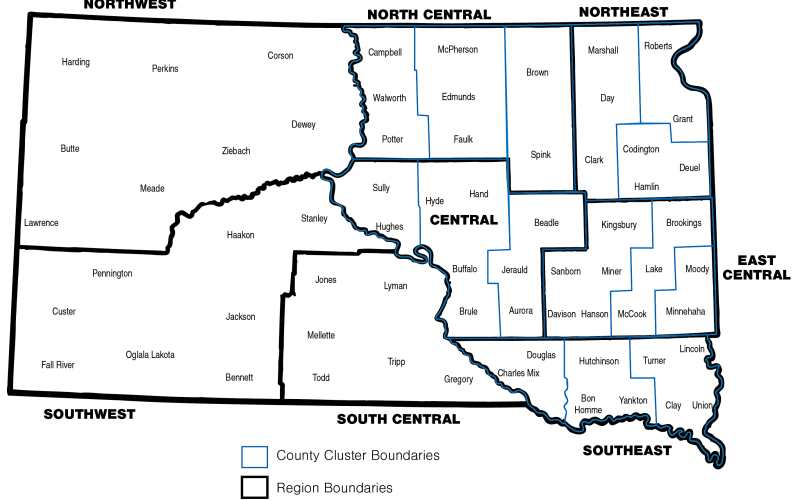
Written collaboratively by Tracey Erickson, former SDSU Extension Dairy Field Specialist, Heidi Carroll, former SDSU Extension Livestock Stewardship Field Specialist & Beef Quality Assurance Coordinator, and Connie Strunk, SDSU Extension Plant Pathology Field Specialist.
Continuing to keep employees and family members healthy through the COVID-19 pandemic will require extra effort as you enter the busy time of fall harvest. Just as important is to ensure harvest and chores get done if someone becomes ill.
Communication Considerations
Given the COVID-19 pandemic, daily communication to your family and non-family employees is critical to help protect the health and well-being of everyone. For example, consider how you and your employees are going to communicate while still practicing social distancing. Will you continue to have a daily check-in with employees utilizing technology such as cell phones or radios, will you gather and stay six to ten feet apart or will you utilize face coverings if meetings are indoors where social distancing is difficult?
Other considerations include:
- Remind people to avoid handshaking and encourage utilizing other forms of greetings such as elbow taps, waves, toe taps and smiles.
- Communicate non-verbally by utilizing appropriate signage and training videos to help convey the message to help understand COVID-19.
- If language may be a barrier, English and Spanish resources are available through the UMASH website or the National Milk Producers Federation website.
- Make sure to take time to communicate with your employees on all shifts regarding your sick leave policy.
- Consider the federal labor legislation and determine how it may apply to you and your employees. Direct questions to the US Department of Labor (1-866-487-9243 or 1-877-889-5627).
Employees are wanting reassurance and guidance from you. Let them know they are encouraged to speak up, sooner rather than later. Especially if they are ill or showing symptoms and why this is important for them and everyone around them. Remind them if they are sick they need to stay home and that they will not lose their job.
No, we do not know exactly how long this situation will last, but give reassurance to employees through regular communication that you are monitoring the situation and will reevaluate the practices and determine next steps or changes as warranted. After all, nothing is more tiring on people than adding more cleaning tasks to their daily duties.
Doing Business On And Off Farm

Producers will need to be aware of state and local mandates regarding COVID-19 that are in place in communities where business is conducted. Such as the need to wear face coverings within indoor spaces and social distance requirements or if “Essential Food and Agricultural Work Permits” are required when transporting items.
Make sure your employees understand the mandates before conducting business on your behalf. For example, if they are delivering grain or livestock to another community, picking up feed, medical supplies, or parts. Have a supply of face coverings available for employees. If you aren’t sure if mandates exist, a good place to start is City Council/Offices for clarification or contact the local businesses directly in advance.
Continue to communicate with your family and non-family employees about the ever-changing situation and review of protocols you have developed utilizing the 5 W’s. Tell them What, Who, Why, Where and How. Finally, make sure you are a good example by practicing the guidelines set forth yourself.
On-Farm Protocols to Consider/Implement
Employee Daily Tasks.
- Cross train employees ahead of time, so they have an understanding of other jobs on the farm if the need would arise for help in other areas on the farm. This should apply to both animal related tasks and how to operate different tractors or equipment.
- Develop a contingency plan for family and non-family employees if you are short staffed. Identify people that may be able to help you temporarily during this time.
- Outline the basic hygiene practices recommended at work, home, and before travelling between work and home. Remind them of hand-washing protocols using soap and water for at least 20 seconds.
- Make sure soap and water is available. This may be something as simple as a watercooler filled up daily with a bottle of soap and paper towels accessible if no running water is available or if hand-sanitizer is not available.
- Decide how you will handle tasks that require close interactions, such as milking, maternity pens, veterinary pens, working chutes, or load-out chutes. If you are a grain farmer, how will you handle grain, seed, fertilizer, or chemical deliveries? Many businesses are putting in no or minimal contact protocols and it is recommended to call ahead to know how they will handle the day-to-day business exchanges.
Extra cleaning and disinfection on farms.
- Disinfect common areas regularly and stagger breaks and arrival times, if possible, to help with social distancing.
- Remind employees to disinfect common areas after each break including counters, tables, microwave handles, microwave control panels, coffee pots, beverage dispensers, refrigerator door handles, cupboard door handles, etc.
- Keep disinfectant, clean cloths and extra garbage bags available at all times.
- Have someone designated to disinfect other common areas one to two times daily, including time clocks, bathrooms, two-way radios, computer keyboards, equipment cabs, and common in-out doors using approved surface disinfectants.
- Do not share used materials (e.g. towels, kitchen utensils, pens), and wash and dry them between uses. Create a “clean” group and a location to place “dirty” items that will need cleaning.
- Launder all clothing or uniforms daily.
- When handling clothing and towels, wear gloves, do not shake the clothes so it minimizes particle dispersion and disinfect clothing hampers.
Entrance and Farm Signage.
- Designate a single entry/exit point to the farm to control all non-essential or visitors potentially gaining access to the farm. Consider not allowing outside visitors for the time being.
- Utilize a log of people coming and going from the farm or use technology and a camera to log all people coming and going.
- Post signage with clear directions for each type of delivery you may be receiving including: who to call, phone number, location to place packages. If possible, encourage staggered delivery times.
- Utilize signage to remind workers to wear the appropriate Personal Protective Equipment (PPE) given the job they are performing including: gloves, footwear, safety glasses or goggles, aprons, masks and replace supplies of PPE as necessary.
Personal interactions for everyday tasks and overall farm management.
- Limit people riding in harvest equipment cabs. If they are unable to social distance, they should wear a face covering. This is especially important for industry reps who travel frequently or on-farm repair personnel.
- Have critical parts on hand and determine what each service provider / company is implementing with their staff, that may impact the on-farm service you receive (e.g. tractor or combine repairs or parlor servicing).
- Determine which few employees will be directly interacting with anyone that comes to do equipment maintenance. Preparation prior to the visit will save time for all parties involved.
- Plan ahead for supply chain disruptions such as cleaning or disinfectant supplies utilized on dairies or swine operations or medications. Contact suppliers of fertilizer, feed, chemical, parts, etc. to see if there is additional wait times.
- Are grain elevators limiting number of trucks or having adjusted delivery times? Will wait times be adjusted any more than normal harvest times?
- Have critical parts on hand and determine what each service provider / company is implementing with their staff that may affect the on-farm service you receive (e.g. tractor or combine repairs or parlor servicing).
- It is recommended to limit carpooling to employees that are essential use, work the same shift, and live together. Consider what to do if employees also carpool with other individuals that do not work on your farm or ranch, or with non-family members? Guidelines for carpooling can be found within these CDC guidelines for carpooling.

Personnel Care/Work-Home Balance
- Encourage workers not to enter their personal home with potentially contaminated clothing. Whenever feasible, they should either wash-up or shower and wear clean clothing home or remove work clothing before entering the home and place in a bag to be laundered (preferably outside the main living space or in a garage/entry/laundry room) and wash-up or shower immediately. This will help minimize bringing the virus home to family members.
- Encourage everyone to monitor travel in the present day and upcoming. Be aware of people you are spending 15-30 minutes with inside of spaces that do not allow you to be six feet apart. If someone becomes ill, all individuals that were in close contact will be traced by health officials/representatives to determine the need for quarantine and testing measures.
- Be aware of employees with families experiencing childcare closures or adjusted school schedules. Consider that many families may have situations where one parent is deemed “essential” and the other is working remotely; there may be concern around the essential worker bringing home the virus. Consider adjusted store hours as employees need to access personal supplies.
- Post local resources for mental health hotlines, telemedicine and as many other community service programs as possible, so everyone can remain connected within the community and get their needs met. The South Dakota Helpline Center can be accessed here or by calling 1-800-273-8255 or 2-1-1.
In Summary
Protecting yourself and others cannot be stressed enough while trying to keep farm and ranch tasks running smooth. Lead by example; wash, disinfect accordingly, practice good social distancing, wear face masks when appropriate and stay home if you are sick. Take the time to plan for the what-ifs of an unforeseen illness during the busiest times of year to ensure the important tasks can get done with the least amount of stress. This protects your people, animals, and the livelihood of your business.
Additional Resources:
- UMASH Covid-19 Resources
- National Milk Producers Federation Coronavirus Webpage
- Coronavirus (COVID-19) Prevention and Management Dairy Farmer Hand Book
- CDC COVID-19 Resources – Resources in multiple languages can be printed and distributed.
- Disinfectants and Work-related Asthma: Information for Workers: English, Espan͂ol
- COVID-19 and Food Safety: A resource for growers that answers common questions about how to approach hand-washing and sanitation on produce farms
- Center of Disease Control (CDC): Responsible for public health efforts in the US. Offers reliable evidence-based information on COVID-19. English, Espan͂ol
- Swine Barn Recommendations


